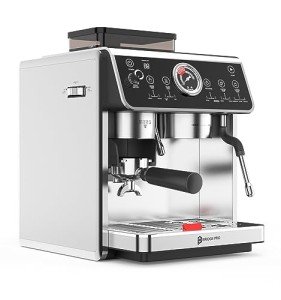The World of High-Quality Espresso Machines: A Comprehensive Guide
Espresso has ended up being a beloved beverage among coffee lovers worldwide, known for its abundant flavor, intense fragrance, and versatility. The heart of a great espresso lies in the machine used to brew it. Espresso Machines Under £1000 -quality espresso machines are created to deliver the perfect shot, making them a vital financial investment for coffee lovers. This article checks out different types of high-quality espresso machines, their features, maintenance suggestions, and responses to often asked concerns.
Types of High-Quality Espresso Machines
High-quality espresso machines fall into several categories, catering to various choices, ability levels, and spending plans. The main types include:
| Type of Machine | Description | Ideal User |
|---|---|---|
| Manual Espresso Machines | Needs user skill to control extraction and pressure. Provides the most control over the developing procedure. | Experienced baristas and enthusiasts |
| Semi-Automatic Machines | Combines manual operation with automation. Users control the grind and tamping, while the machine manages water dispersion. | Intermediate users |
| Automatic Espresso Machines | Automate the developing process, enabling for programmable brewing times and temperatures. | Casual coffee drinkers |
| Super-Automatic Machines | Have integrated mills and are totally automated, managing everything from grinding to developing and steaming. | Users seeking benefit |
| Commercial Espresso Machines | Designed for high volume use in coffee shops and restaurants, providing sturdiness and speed. | Company owner |
Comprehensive Overview of Each Type
Manual Espresso Machines
- Pros: Complete control over the developing process; can produce exceptional quality espresso.
- Cons: Requires significant ability; lengthy.
Semi-Automatic Machines
- Pros: Balanced control, mixing manual and automatic processes; superior quality espresso is still attainable.
- Cons: Requires some knowledge and experience to master.
Automatic Espresso Machines
- Pros: User-friendly; reduces the discovering curve while still producing high-quality espresso.
- Cons: Still requires some understanding of coffee-making fundamentals.
Super-Automatic Machines
- Pros: Maximal convenience; little skill needed; ideal for people or households who desire coffee without hassle.
- Cons: Higher rate point; might do not have the fine-tuning capabilities of manual machines.
Commercial Espresso Machines
- Pros: Built for durability and performance; frequently consists of functions for high-volume turns.
- Cons: Expensive; might be overkill for home use.
Secret Features to Consider
When searching for a high-quality espresso machine, several crucial functions must be taken into account:
- Pressure and Pump Type: Look for machines with a minimum of 9 bars of pressure, which is necessary for extracting the best taste from coffee beans.
- Boiler Type: Single, double, and heat exchanger boilers each affect how the machine carries out and the speed of brewing.
- Build Quality: High-quality materials such as stainless-steel are preferable for toughness and aesthetic appeals.
- Ease of Use and Cleaning: Some machines need comprehensive cleansing, while others are created for simple maintenance.
- Temperature Control: Consistent temperature level is important; think about machines with PID controllers for precise control.
Benefits of High-Quality Espresso Machines
Investing in a high-quality espresso machine provides a multitude of advantages:
- Superior Quality: High-end machines permit for greater control, leading to tastier espresso.
- Durability: Built to last, quality machines need fewer repairs and replacements.
- Personalization: Users can take pleasure in a customized experience by changing grind size, shot timing, and other settings.
- Increased Convenience: Automatic and super-automatic options allow fanatics to delight in espresso with minimal effort.
Maintenance and Care for High-Quality Espresso Machines
To keep an espresso machine functioning efficiently, regular maintenance is essential. Here are pointers for maintaining a high-quality espresso machine:
Descale Regularly:
- Use a descaling solution every couple of months to prevent accumulation of minerals from water, which can impact taste and efficiency.
Clean the Brew Group:
- For machines with a removable brew group, tidy it frequently to guarantee a clean extraction.
Change Water Filters:
- Use a water filter and alter it as required to decrease impurities in your developing water.
Daily Cleanings:
- Rinse the portafilter and group head after each use to avoid oil accumulation.
Keep an Eye on the Parts:
- Monitor seals, gaskets, and other parts for wear and tear and replace them as needed.
Frequently Asked Questions (FAQs)
1. What is the best espresso machine for beginners?
For newbies, a semi-automatic machine often provides a great balance of use and control, allowing users to find out the skills needed for making excellent espresso.
2. Are Espresso Machines Under £500 -automatic machines worth the financial investment?
Yes, for those who prioritize benefit and ease over control, super-automatic machines can be a worthwhile investment, especially for families or busy professionals.
3. How much should I anticipate to invest in a high-quality espresso machine?
High-quality espresso machines vary significantly in rate, with manual machines beginning at a couple of hundred dollars, while super-automatic or commercial machines can go beyond a number of thousand.
4. Can I make other coffee beverages with an espresso machine?
Yes, lots of espresso machines have steam wands or attachments that allow users to develop lattes, coffees, and more.
5. The length of time do espresso machines generally last?
With correct upkeep, high-quality espresso machines can last over a decade, making them a long-term investment in your coffee enjoyment.
High-quality espresso machines yield a transformative coffee experience, whether taken pleasure in at home or in a commercial setting. By comprehending the types offered, their functions, and the upkeep needed to keep them running efficiently, consumers can make educated decisions that raise their coffee-drinking experience.

